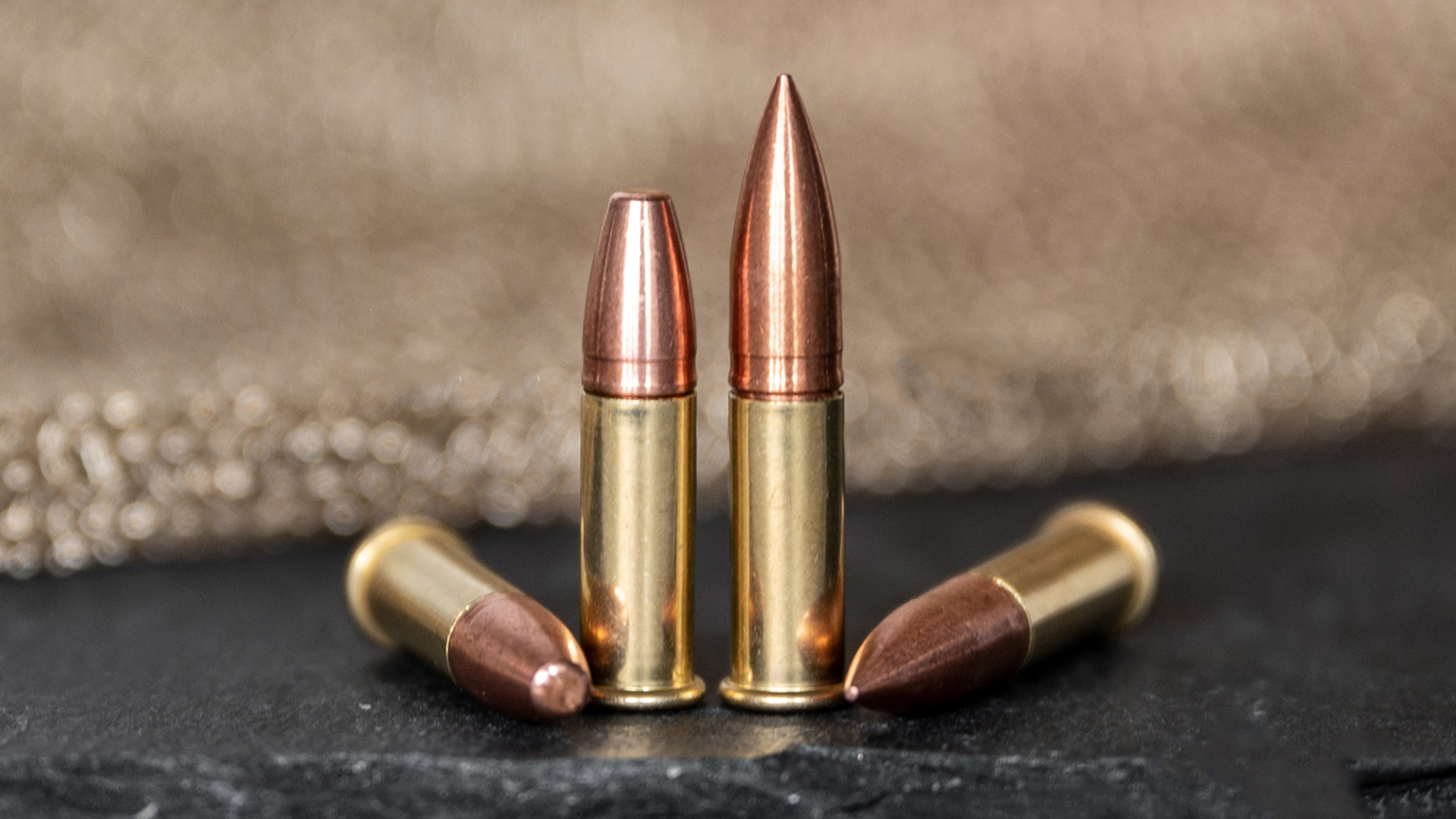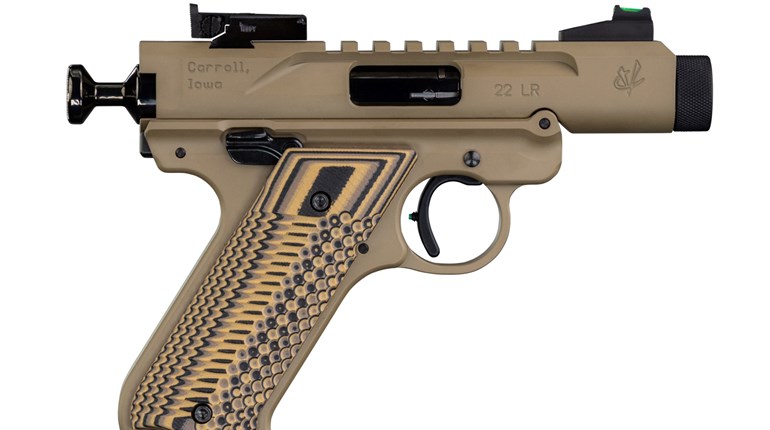
A high-BC bullet for the .22 LR cartridge? It would seem inevitable, given the increasing popularity of “long-range” competition with the .22 LR cartridge, and yet there are the constraints of physics, technical complications and capitalist pragmatism to rein in development. Can it work, and is anyone pursuing the concept? Let’s take a look.

The .22 Short cartridge has been with us since before the American Civil War, developed from Flobert’s 1845 primer-driven Bulleted Breech Cap (.22 BB Cap) by Smith & Wesson and introduced by that company in 1856. The .22 Short is the oldest metallic cartridge still in common production. The new and improved .22 Long hit the unpaved streets in 1871, and by 1887 the J. Stevens Arms & Tool Company had introduced the .22 Long Rifle cartridge. In the intervening 133 years, further evolution of the .22 LR cartridge has included hollow-point bullets, cladding them with copper, increasing or decreasing their weight, lengthening the case and changing powders and charges to produce less fouling and more velocity. Engineers, chemists and ballisticians refined the elements of bullet, powder, primer, case and manufacturing process to produce precision .22 LR ammunition for competition.
Historically, precision NRA Smallbore and Silhouette competitions shooting the .22 LR has been confined to comparatively short range, out to a maximum of 100 yards or meters—not much more than Olympic archery distance. Some increasingly popular new .22 LR competitions, however, shoot much farther than that, making new demands on the old cartridge.
Though some .22 LR hunting ammunition can exceed 1,700 f.p.s., match-grade .22 LR ammo is typically loaded only to the very edge of supersonic speed, which is roughly 1,100 f.p.s. at sea level and decreasing with thinner air at higher altitude. When supersonic bullets decelerate below that threshold (become “transonic”), they depart from stable flight and can tumble erratically. This is a cause of bullets “keyholing” target paper that you’ve heard about or experienced, as they turn completely sideways before striking the target. This phenomenon is one reason why match-grade .22 LR has such a comparatively low muzzle velocity, to keep the bullets from hitting that transonic wall and departing stable flight.
Centerfire cartridges in long-range competition intend their bullets to remain supersonic all the way to the target in order to avoid hitting that wall. They can accomplish this with brute force by launching at highest possible velocity, or with the assistance of a high ballistic coefficient (BC). BC measures a bullet’s drag, or from the opposite perspective, a bullet’s ability to overcome air resistance to maintain its velocity.
Starting a .22 LR bullet at supersonic speed isn’t so tough, just add more powder or a lighter bullet. But maintaining that speed at extended ranges—300, 400 and 500 yards in today’s .22 LR long-range competitions—has a few things going against it.
The Physics
Firstly, most .22 LR bullets (and all match-grade .22 LR bullets) have round noses, about the best configuration imaginable to cripple a bullet’s BC. Compared to spitzer (pointed) bullets, such bullets are the equivalent of drag racing with your parking brake set. In addition, their bullets are universally lead, sometimes clad with a thin plating of copper or copper alloy. Wouldn’t a high-BC bullet require protective jacketing? How would that impact internal ballistics of this fairly anemic cartridge?
Complicating matters, the .22 LR bullet is a heel-base design, meaning the back end of the bullet that protrudes into the case is a lesser diameter than the forward part, which is basically the same diameter as the case itself. That heel base limits the capacity of the .22 LR case, which typically holds a charge of 1 to 1.5 grains of powder. But perhaps more important is the question of how the drag of that necessary heel base may limit any improvement to BC.

Yet, witness the modern Lapua 0.309-inch rebated boat-tail bullet (see photo above). That rebated boat-tail is very reminiscent of the .22 LR’s heel-base bullet. And once you’ve got a boat-tail attached, much of any bullet’s BC is determined by the design profile of the forward portion. Could we scale the Lapua bullet down to 0.225 inch and around 35 to 40 grains and fire it in the .22 LR with results that make the effort worthwhile?
While SAAMI says the .22 LR cartridge overall length (COL) is exactly 1.000 inch, the SAAMI chamber and throat is only 0.8751 inch, so the bullet extends 0.1249 inch into the bore upon chambering. While bullet diameter is 0.2255 inch, bore diameter is 0.217 inch and a high-BC bullet design would have to take this into account as well.
Finally, there is the question of enhanced performance. Can a high-BC .22 LR bullet land smaller groups than standard velocity round-nose bullets at extended ranges?
Faster Twist
There are practical matters to consider, too. For wide acceptance into the .22 LR games fired beyond 100 yards, some of which are of a “tactical” nature requiring rapid firing, a high-BC bulleted .22 LR cartridge would have to fit and feed through existing standard magazines. Reducing the cartridge to a single-loading-only proposition limits its market. That said, Smallbore, Silhouette and Extended Long-Range (ELR) .22 LR competitions have slow-fire stages or time to single-load.
High-BC bullets are necessarily longer than standard bullets and generally require a faster twist rate. Barrel manufacturers would have to up the .22 LR’s standard 1:16-inch twist to stabilize high-BC bullets. From a marketing standpoint, any maker of high-BC .22 LR ammunition would have to depend on gun makers turning out barrels with faster twists. One major bullet and ammunition maker I queried said they decline to pursue a high-BC .22 LR partly because of that dependency.

Also limiting is whether such a cartridge can be manufactured at a competitive price point to appeal to the expanding market of PRS and NRL .22 LR-style shooters. The original intent of competing with the .22 LR at extended range is to make the challenge of shooting long range more affordable and more available to more people, and anything beyond 100 yards is long range for a .22 LR. In my limited experience shooting the NRL-style .22 LR tactical game out to 300 yards, I see few competitors shooting the most expensive match-grade .22 LR ammunition. Instead, most go for match-grade ammo a step or two below the most expensive stuff. That is, I see competitors shooting $6 to $12 per box of ammo, but not the $16 to $21 per box for ultra-premium offerings. But that’s a narrow, subjective observation, and other games (and competitors) are less concerned with a philosophy of frugality.
Working On It
Is anybody working on this concept of a high-BC .22 LR bullet? Queries sent out to major ammunition makers indicate that some are not, some are just beginning to investigate the feasibility and others may be holding their cards close to their chests.
One smaller business can answer, “Yes.” Cutting Edge already enjoys popularity among centerfire King of 2 Miles competitors, and the company is now manufacturing improved- BC, lathe-tuned copper bullets for the .22 LR. These are not loaded cartridges, only the bullets, which have a patent pending. Their 32-grain bullet will perform in standard 1:16-inch twist barrels. There’s also a 42-grainer that requires a faster, custom twist, and an even heavier bullet coming in the near future. Cutting Edge anticipates having the bullets, dies and premium primed brass available for handloaders by Spring 2021 (yes, you can handload .22 LR) and intends to offer loaded cartridges later in the year.
How improved is the BC over standard factory round-nose .22 LR bullets? On the surface, it appears the answer is, “Not much.” However, BC is a slippery definitive because part of its calculation is based on velocity. While factory .22 LR round-nose bullets have BCs in the 0.072 to 0.149 range for bullets of 26 to 40 grains started at typical low .22 LR velocities, the Cutting Edge bullets come in at only about 0.111 (G1 BC), according to the company’s president, Dan Schmitko. But unlike standard factory fare, the Cutting Edge bullets are intended to start at higher velocity (1,450 f.p.s. or more for the 32-grain bullet), and then their design will apparently keep them supersonic at extended ranges. With this approach, these bullets avoid hitting that transonic wall, and they reach the target faster, with less drop over distance.

Schmitko also addressed some of those concerns mentioned earlier. “It is not feasible to make a high-BC bullet that will fit and feed in standard production rifles,” he said. “What is feasible is a lighter bullet that has a reasonable BC that shoots at a much higher velocity than standard .22 LR rounds. Our high-BC 42-grain version will require single loading or modifications allowing for a longer cartridge overall length. The throat configuration of production rifles will work fine for these bullets, but the twist rate will have to be 1:9 inches or faster, which is not standard on production rifles.”
But are such cartridges with exaggerated overall length still really .22 LR? Refer to the .357 Mag. and .38 Spl. relationship; they physically differ only in case length, but they are definitely not the same cartridge. Yet the Cutting Edge bullets don’t necessarily require altering the .22 LR chamber—though that may improve performance even further—only the twist rate to stabilize its greater length.
Single-loading only leaves out the .22 LR tactical-style games, as even at extended ranges, the time limits require feeding cartridges from a magazine. But that isn’t the only game in town, and there’s the aforementioned ELR .22, which is where Cutting Edge has its eyes at the moment. “Our longer, heavier bullets are being developed for the rimfire ELR competitions where there are no limitations as to what is being shot,” Schmitko said.
It appears then, that an improved-BC .22 LR bullet, though facing some present limitations, is doable—and might be harbinger for new games, or even an entirely new .22-caliber rimfire cartridge. Perhaps what’s important is not attempting to conform to existing rules and games, but innovation itself. Pushing the envelope of accepted practice and dogma has its risks for failure, but it is precisely the takingon of challenge that brought us where we are today. Who knows where the pursuit of high- BC bullets in the .22 LR may lead?
See more: WATCH: Behind The Scenes At The Winchester Centerfire Ammunition Plant



































